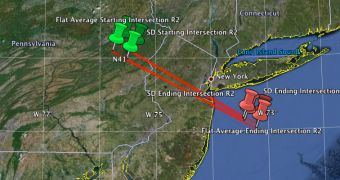This past Friday evening, around 7:50 p.m., a meteor flew over the US East Coast. Due to the meteor's putting on quite a show, millions got the chance to become aware of its presence and take one good look at it as it passed through the sky.
By the looks of it, the meteor was spotted by millions of people spread across 13 different American states and even two Canadian provinces.
Most of them were quick in using either Twitter or some other similar sites in order to share their experience with others.
According to Space, it only took about ten minutes since the meteor was first spotted until the American Meteor Society began receiving hundreds of eyewitness reports.
Robert Lunsford, one of the researchers currently working with the American Meteor Society, made a case of how, “The witnesses range from along the Atlantic Coast ranging from Maine to North Carolina. This object was also seen as far inland as Ohio.”
“Strange Friday night … a meteor passed over my house tonight!” a so-called Yanksmom19 from New York said in an online post.
Specialists are now referring to this meteor as a fireball, and explain that its looking fairly similar to a shooting star was a direct result of its being rather large.
Thus, most of the meteors approaching our planet are roughly the size of pebbles, hence their more often than not going unnoticed. However, this particular one was big enough to light up the sky as it passed over the US East Coast.
“For those not familiar with meteors and fireballs, a fireball is a meteor that is larger than normal. Most meteors are only the size of small pebbles. A meteor the size of a softball can produce light equivalent to the full moon for a short instant. The reason for this is the extreme velocity at which these objects strike the atmosphere,” Robert Lunsford wrote on the official website for the American Meteor Society.
“Fireballs occur every day over all parts of the Earth. It is rare though for an individual to see more than one or two per lifetime as they also occur during the day, on a cloudy night, or over a remote area where no one sees it,” Robert Lunsford went on to argue.
Despite the fact that most people assumed that the meteor came fairly close to Earth, specialists wish to stress the fact that the space rock's flight path was most likely located at a distance of hundreds of miles away.
As Robert Lunsford puts it, “It is your perspective that makes meteors appear to strike the horizon when in fact they are still high in the atmosphere.”

 14 DAY TRIAL //
14 DAY TRIAL //